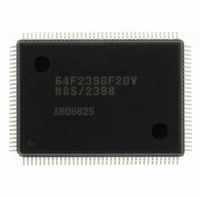DF2398F20V Renesas Electronics America, DF2398F20V Datasheet - Page 563

DF2398F20V
Manufacturer Part Number
DF2398F20V
Description
IC H8S/2300 MCU FLASH 128QFP
Manufacturer
Renesas Electronics America
Series
H8® H8S/2300r
Specifications of DF2398F20V
Core Processor
H8S/2000
Core Size
16-Bit
Speed
20MHz
Connectivity
SCI, SmartCard
Peripherals
DMA, POR, PWM, WDT
Number Of I /o
87
Program Memory Size
256KB (256K x 8)
Program Memory Type
FLASH
Ram Size
8K x 8
Voltage - Supply (vcc/vdd)
4.5 V ~ 5.5 V
Data Converters
A/D 8x10b; D/A 2x8b
Oscillator Type
Internal
Operating Temperature
-20°C ~ 75°C
Package / Case
128-QFP
For Use With
YR0K42378FC000BA - KIT EVAL FOR H8S/2378
Lead Free Status / RoHS Status
Lead free / RoHS Compliant
Eeprom Size
-
Available stocks
Company
Part Number
Manufacturer
Quantity
Price
Company:
Part Number:
DF2398F20V
Manufacturer:
Renesas Electronics America
Quantity:
135
Company:
Part Number:
DF2398F20V
Manufacturer:
Renesas Electronics America
Quantity:
10 000
- Current page: 563 of 1049
- Download datasheet (5Mb)
If a parity error occurs during reception and the PER is set to 1, the received data is still transferred to RDR, and therefore
this data can be read.
Mode Switching Operation: When switching from receive mode to transmit mode, first confirm that the receive
operation has been completed, then start from initialization, clearing RE bit to 0 and setting TE bit to 1. The RDRF flag or
the PER and ORER flags can be used to check that the receive operation has been completed.
When switching from transmit mode to receive mode, first confirm that the transmit operation has been completed, then
start from initialization, clearing TE bit to 0 and setting RE bit to 1. The TEND flag can be used to check that the transmit
operation has been completed.
Fixing Clock Output Level: When the GSM bit in SMR is set to 1, the clock output level can be fixed with bits CKE1
and CKE0 in SCR. At this time, the minimum clock pulse width can be made the specified width.
Figure 15-8 shows the timing for fixing the clock output level. In this example, GSM is set to 1, CKE1 is cleared to 0, and
the CKE0 bit is controlled.
Interrupt Operation: There are three interrupt sources in Smart Card interface mode: transmit data empty interrupt (TXI)
requests, transfer error interrupt (ERI) requests, and receive data full interrupt (RXI) requests. The transmit end interrupt
(TEI) request is not used in this mode.
When the TEND flag in SSR is set to 1, a TXI interrupt request is generated.
When the RDRF flag in SSR is set to 1, an RXI interrupt request is generated.
When any of flags ORER, PER, and ERS in SSR is set to 1, an ERI interrupt request is generated. The relationship
between the operating states and interrupt sources is shown in table 15-8.
Table 15-8 Smart Card Mode Operating States and Interrupt Sources
Data Transfer Operation by DMAC or DTC: In Smart Card mode, as with the normal SCI, transfer can be carried out
using the DMAC or DTC. In a transmit operation, the TDRE flag is also set to 1 at the same time as the TEND flag in
SSR, and a TXI interrupt is generated. If the TXI request is designated beforehand as a DMAC or DTC activation source,
the DMAC or DTC will be activated by the TXI request, and transfer of the transmit data will be carried out. The TDRE
Operating State
Transmit
Mode
Receive
Mode
SCK
Normal
operation
Error
Normal
operation
Error
Figure 15-8 Timing for Fixing Clock Output Level
Flag
TEND
ERS
RDRF
PER, ORER
Specified pulse width
SCR write
(CKE0 = 0)
Enable Bit
TIE
RIE
RIE
RIE
SCR write
(CKE0 = 1)
Interrupt
Source
TXI
ERI
RXI
ERI
Specified pulse width
DMAC
Activation
Possible
Not possible Not possible
Possible
Not possible Not possible
Rev.6.00 Oct.28.2004 page 533 of 1016
DTC
Activation
Possible
Possible
REJ09B0138-0600H
Related parts for DF2398F20V
Image
Part Number
Description
Manufacturer
Datasheet
Request
R

Part Number:
Description:
CONN PLUG 12POS DUAL 0.5MM SMD
Manufacturer:
Hirose Electric Co Ltd
Datasheet:

Part Number:
Description:
CONN PLUG 18POS DUAL 0.5MM SMD
Manufacturer:
Hirose Electric Co Ltd
Datasheet:

Part Number:
Description:
CONN PLUG 14POS DUAL 0.5MM SMD
Manufacturer:
Hirose Electric Co Ltd
Datasheet:

Part Number:
Description:
CONN RECEPT 20POS DUAL 0.5MM SMD
Manufacturer:
Hirose Electric Co Ltd
Datasheet:

Part Number:
Description:
CONN PLUG 16POS DUAL 0.5MM SMD
Manufacturer:
Hirose Electric Co Ltd
Datasheet:

Part Number:
Description:
CONN RECEPT 16POS DUAL 0.5MM SMD
Manufacturer:
Hirose Electric Co Ltd
Datasheet:

Part Number:
Description:
CONN PLUG 20POS DUAL 0.5MM SMD
Manufacturer:
Hirose Electric Co Ltd
Datasheet:

Part Number:
Description:
CONN PLUG 30POS DUAL 0.5MM SMD
Manufacturer:
Hirose Electric Co Ltd
Datasheet:

Part Number:
Description:
CONN RECEPT 30POS DUAL 0.5MM SMD
Manufacturer:
Hirose Electric Co Ltd
Datasheet:

Part Number:
Description:
CONN PLUG 40POS DUAL 0.5MM SMD
Manufacturer:
Hirose Electric Co Ltd
Datasheet:

Part Number:
Description:
KIT STARTER FOR M16C/29
Manufacturer:
Renesas Electronics America
Datasheet:

Part Number:
Description:
KIT STARTER FOR R8C/2D
Manufacturer:
Renesas Electronics America
Datasheet:

Part Number:
Description:
R0K33062P STARTER KIT
Manufacturer:
Renesas Electronics America
Datasheet:

Part Number:
Description:
KIT STARTER FOR R8C/23 E8A
Manufacturer:
Renesas Electronics America
Datasheet:

Part Number:
Description:
KIT STARTER FOR R8C/25
Manufacturer:
Renesas Electronics America
Datasheet:











